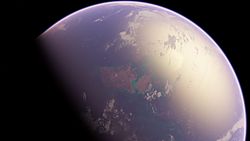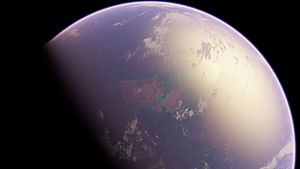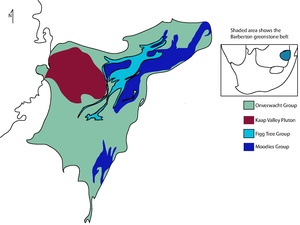Paleoarchean facts for kids
Quick facts for kids Paleoarchean |
|
|---|---|
| 3600 – 3200 Ma | |

|
|
| Chronology | |
|
Paleoarchean graphical timeline
-3600 —
–
-3550 —
–
-3500 —
–
-3450 —
–
-3400 —
–
-3350 —
–
-3300 —
–
-3250 —
–
-3200 —
–
Events of the Paleoarchean.
Axis scale: millions of years ago. |
|
| Proposed redefinition(s) | 4031–3490 Ma Gradstein et al., 2012 |
| Proposed subdivisions | Acastan Period, 4031–3810 Ma Gradstein et al., 2012 |
| Etymology | |
| Name formality | Formal |
| Alternate spelling(s) | Palaeoarchaean |
| Synonym(s) | Early Archean |
| Usage information | |
| Celestial body | Earth |
| Regional usage | Global (ICS) |
| Time scale(s) used | ICS Time Scale |
| Definition | |
| Chronological unit | Era |
| Stratigraphic unit | Erathem |
| Time span formality | Formal |
| Lower boundary definition | Defined Chronometrically |
| Lower GSSA ratified | 1991 |
| Upper boundary definition | Defined Chronometrically |
| Upper GSSA ratified | 1991 |
The Paleoarchean (pronounced PAY-lee-oh-ar-KEE-ən) is a very old geologic era within the Archean Eon. Its name comes from the Greek word "Palaios," meaning ancient. This era lasted from about 3.6 billion to 3.2 billion years ago.
During the Paleoarchean, the first clear signs of life appeared on Earth. It was also a time when Vaalbara, one of Earth's earliest supercontinents, might have started to form.
Contents
Discovering Early Life on Earth

Finding evidence of early life from the Paleoarchean era is very hard. Most rocks from this time have been changed a lot by heat and pressure. This means they can't tell us much about ancient life.
However, scientists have found two special places where rocks are still good enough to show signs of early life. These are the Kaapvaal Craton in Southern Africa and the Pilbara Craton in Western Australia. A craton is a very old and stable part of the Earth's continental crust.
Life in the Pilbara Craton
The Dresser Formation is in the Pilbara Craton. It has sedimentary rocks that are about 3.48 billion years old. These rocks contain many signs of ancient life. This includes stromatolites and structures made by microbial mats. Microbial mats are like thin layers of tiny living things, similar to bacteria. These mats are some of the oldest known forms of life on Earth.
Another place in the Pilbara Craton is the Strelley Pool Chert. It also has stromatolites that might have been made by bacteria about 3.4 billion years ago. However, some scientists think these stromatolites might have formed naturally, without living things.
Life in the Kaapvaal Craton
The Barberton Greenstone Belt in the Kaapvaal Craton also shows signs of early life. This area formed around 3.26 billion years ago. This happened when a huge asteroid, about 37 to 58 kilometers wide, crashed into Earth.
Two rock formations there, the Buck Reef chert and the Josefsdal chert, contain fossilized bacteria from the Paleoarchean era. These bacteria were part of microbial mats. The Kromberg Formation, another part of this belt, is about 3.416 to 3.334 billion years old. It shows evidence of microbial life that reproduced by splitting into two or more new cells.
How Continents Developed


Scientists have noticed similarities between the Barberton Greenstone Belt in Africa and the eastern part of the Pilbara Craton in Australia. This suggests that these two landmasses were once connected. They might have been part of a giant supercontinent called Vaalbara. Vaalbara is thought to be one of Earth's very first supercontinents. Both cratons formed at the start of the Paleoarchean era.
Some studies of ancient magnetism in rocks suggest they were connected during the Paleoarchean. However, it's also possible that Vaalbara didn't fully form until later eras, like the Mesoarchean or Neoarchean.
Land Above Water
It's not clear if there was any dry land during the Paleoarchean era. Some rock formations, like the Dresser Formation, show signs they might have been above the ocean. But over 90 percent of the Archean continental crust has been destroyed over time. This makes it very hard to know for sure if any land was exposed.
It's likely that a lot of continental crust existed during the Paleoarchean. However, most of it was probably still underwater. It might not have risen above the sea until later in the Archean era. Small hotspot islands might have been the only dry land at that time.
Plate Tectonics in the Paleoarchean
The Earth's interior was much hotter during the Paleoarchean than it is today. This means that plate tectonics, as we know it, didn't exist back then. Instead, scientists suggest a model called "flake tectonics."
In this model, instead of oceanic plates sliding under each other (subduction), the top layers of the oceanic crust would peel off. These layers would then sink and be deposited in a way similar to how ophiolites formed in later eons.
See also
 In Spanish: Era Paleoarcaica para niños
In Spanish: Era Paleoarcaica para niños

